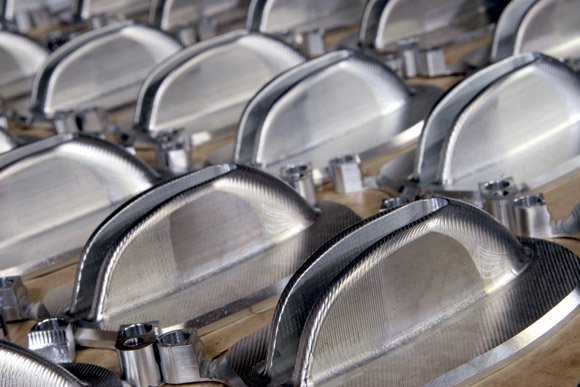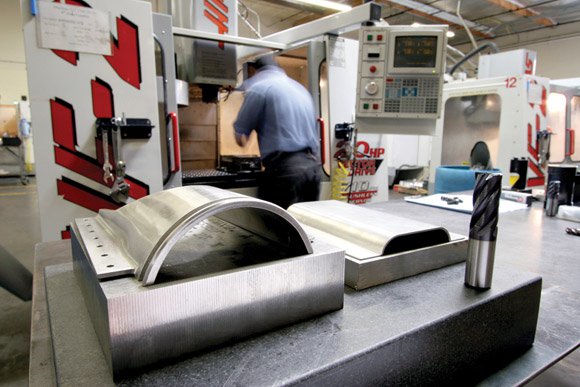Cutting Time
While this maxim may seem counterintuitive, it reveals a successful path to faster removal rates in titanium. To realize the highest gains, you first must determine the limits of a new tool design – and pushing a large endmill to its point of failure can get a little scary.
Titanium is used extensively in aerospace and military applications, as are Inconel® and other exotic materials. Michael Allawos, President of Mikana Manufacturing Company of San Dimas, California, knows this all too well. “We started in 1985, primarily in the aerospace industry,” he remarks. “We are sought out for the one-of-a-kind stuff that we do, and the hard-to-produce parts we make from hard-to-machine metals.”
In the past few years, however, prices for aerospace metals have skyrocketed, making material costs a much larger factor in the profit-and-loss equation. To cut costs and remain competitive, Allawos realized that Mikana would have to increase production speed. He would have to cut titanium and Inconel faster, and that meant he had to innovate.
Knowing that the machine and the process were only parts of the solution, he searched for a tooling company that would assist his effort to pioneer a new method to cut titanium. He eventually found a perfect partner: Jonathan Saada and Associates of Thousand Oaks, California, distributors of Hanita® cutting tools.
“This is a three-way marriage!” Jonathan Saada exclaims, referring to the cooperative relationship between his company, Mikana and Haas Automation Saada supplies innovative cutting tools and Mikana provides the arena and expertise to test the new ideas. Because of its stability – and the thorough support provided by Haas service engineers and the Haas factory – a Haas VF-2 with a high-tension drawbar is the preferred test machine. The results of their combined innovation defy many theories about cutting problematic metals.
Most of the parts Mikana produces are made of hard, abrasive Inconel or titanium, which traditionally are subjects of slower feedrates. “Everything in machining is measured in cubic inches per minute [of material removal],” explains Allawos. “It is often the measure of profit or loss. Faster removal rates and longer tool life mean more production, and some of the parts we produce here require large amounts of material removal. It’s all about cutting the cycle time.”

How much material removal? Allawos holds up a large block of titanium 6-2-2-2-2 and a thin-walled, hollowed-out titanium box. “See this?” he asks. “This thin part was made from a block this size. As you can see, 90% is gone, and six-quad-two titanium is harder and more abrasive than other types.” What’s amazing is that most of the material was removed at feedrates that would unnerve most machinists. Much of the really heavy hogging was done at a feedrate of 80 to 90 inches per minute!
Saada and Allawos decided to address the problem of slow feedrates with a practical approach. “When we first started this project,” says Saada, “I assured Michael that he would not pay for a tool unless it proved itself to be cost effective. But we wanted to know the actual limits of the new tool, so we took it to Mikana’s production manager and told him to break it. We did this for each new tool we tried, documented the results, and finally achieved some very impressive feedrates.”
“I encourage my employees to develop ideas and experiment,” explains Allawos. “If we make one good discovery, the cost savings will pay for it all. We document everything, and we’ve done some amazing things here. We now have techniques that allow us to get good results using speeds and feeds significantly beyond the cutting tool manufacturer’s recommendations, especially in Inconel and titanium.”
“There are three things that work together to produce good cuts in titanium,” Saada reveals. “First is the tool. To help eliminate chatter, we use a tool with uneven geometry, called a VariMill®, to break up the harmonics. It’s coated with titanium aluminum nitride to dissipate the heat.
“The second factor is the use of kellering,” Saada continues. “We use the tip of the ball endmill and work out around the radius. And thirdly, we use the chip-thinning effect.” Chip thinning refers to the technique of using light engagement with a larger section of the tool’s cutting edge to achieve the depth of cut.
“With the coated tool, we can cut 80 to 90 inches per minute in 6-2-2-2-2 titanium,” explains David Buchberger, Saada’s associate. “When you tell someone who is used to machining titanium at 4 inches per minute that he can cut at 80 inches per minute, he kind of steps back and shakes his head in disbelief. When you show him that it actually can be done, he is impressed.”
Saada addresses the problem of work hardening the part, which causes brittleness. “Work hardening, most of the time, is a result of dwelling,” he says. “People are afraid in titanium, so they take a cut of ten thou’, and when they get into a corner they slow down. Where does the heat go? Into the part! Work hardening becomes localized, so you must be continuously moving the tool, always cutting. We use chip-thinning calculations so the heat goes into the chip and not the part!”

Titanium 6-2-2-2-2 is very hard and abrasive, and is no picnic to cut. But neither is 635 Inconel. It is arguably the most difficult metal to machine; cutting tools die quickly in Inconel.
Saada brings out a convoluted plate and a block of Inconel and puts them on the table. “For this part, you can see how we hog out this block,” he points out. “About 95% is gone in chips. We tried endmills of carbide, ceramic inserts and cobalt. They dulled quickly – no life. We finally tried a powdered-metal tool, 12% cobalt, 6% vanadium, coated with titanium aluminum nitride, and that was the right combination.”
“All the other endmills had very short lives, and carbide was so brittle that the cutting edges chipped,” says Buchberger. “They were lasting about 20 minutes in 635 Inconel. Now we’re cutting more than an hour per tool resharp, and we do not recoat between sharps. Here at Mikana, we get three hours of cutting in Inconel with the same 1-inch cutter, and much of that time is spent in a full slot with a 250 thou’ depth of cut – at a full 4 inches per minute!”
But tooling and feedrates alone do not make the process profitable. “One of the most important factors is the Haas VF-2 with the high-tension drawbar,” explains Ed Lujan, Mikana’s production manager. “The drawbar tension took any chatter variable out of the equation. When you cut hard metals, chatter is the machinist’s nightmare. It doesn’t exist on this machine. If you are going to cut a variety of metals, it’s good to have a versatile machine, and I can put any kind of metal I want on that Haas.”
The ability to machine a variety of metals is critical to Mikana’s production and future. “Although we make parts for the F-18, the F-22 and the Joint Strike Fighter, things are now getting a lot more commercial.” Allawos points out. “We work with commercial clients like Lockheed, Boeing (on the 787 program) and JPL. We have about 108 Rover parts that are still running around on Mars. A lot of them were made on our Haas machines.”
Fifty percent of Mikana’s production is titanium and Inconel, but they also machine plastic, foam and aluminum. “This is the tool that rips through aluminum,” says Buchberger, holding up a large, three-flute serrated endmill. “Sub-micrograin carbide. Some people don’t think it’s necessary for aluminum, but it will pay for itself ten times over in tool life and cutting speeds.”
“We even use this tool for cutting floors,” adds Lujan. “We can finish cut unsupported floors up to 6 inches square and 0.045″ thick – and hold 0.005″ tolerance with no problem. Some of the other tools tend to rip up the floors. This is my 90-inch-per-minute, lights-out-running tool.”
About half of the Mikana shop is dedicated to machining titanium. “We want to use our Haas machines for those jobs, because we get better results on them,” Allawos remarks. “It’s a more rigid machine, and better for the harder material.”
One of the big advantages, says Lujan, is that “the Haas machines are all the same. If you can run the VF-2, you can run the VF-4, or the VF-8. The controls are all the same. The things that really make a difference in what we do are feedrate and look-ahead. The Haas control makes difficult jobs easy.”
“We push the limits here, and learn the truth about how fast we can cut, and what the limits are of the tool, the machine and the process,” observes Saada. “We support one another, and we all profit from the other’s ideas and innovation.”
Allawos agrees. “Our innovative spirit generates benefits for all three companies – and, ultimately, for the industry itself.”




